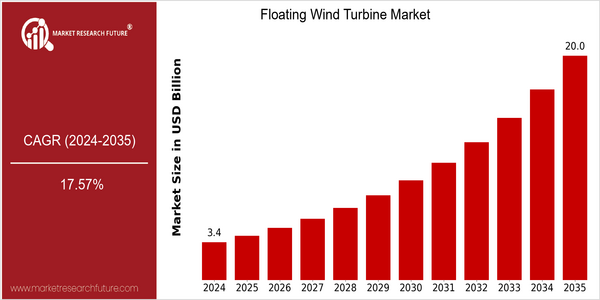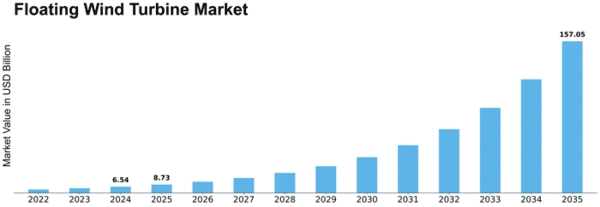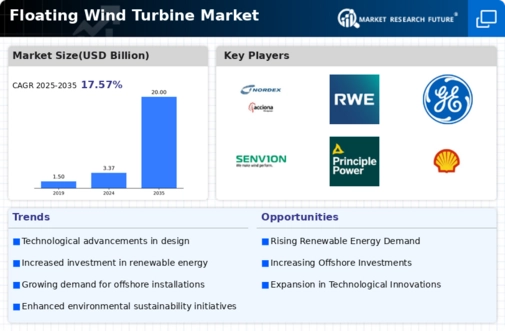-
EXECUTIVE SUMMARY
-
Market Overview
-
Key Findings
-
Market Segmentation
-
Competitive Landscape
-
Challenges and Opportunities
-
Future
-
Outlook
-
MARKET INTRODUCTION
-
Definition
- Research Objective
- Assumption
-
Scope of the study
-
Limitations
-
RESEARCH METHODOLOGY
-
Overview
-
Data Mining
-
Secondary Research
-
Primary Research
- Primary Interviews
- Breakdown of Primary Respondents
-
and Information Gathering Process
-
Forecasting Model
-
Market Size Estimation
- Bottom-Up
- Top-Down Approach
-
Approach
-
Data Triangulation
-
Validation
-
MARKET DYNAMICS
-
Overview
-
Drivers
-
Restraints
-
Opportunities
-
MARKET FACTOR ANALYSIS
-
Value chain Analysis
-
Porter's Five Forces Analysis
- Bargaining Power of Buyers
- Threat of Substitutes
- Intensity
-
Bargaining Power of Suppliers
-
Threat of New Entrants
-
of Rivalry
-
COVID-19 Impact Analysis
- Market Impact Analysis
- Regional Impact
- Opportunity and Threat Analysis
-
FLOATING WIND TURBINE MARKET, BY TECHNOLOGY (USD BILLION)
-
Spar-Buoy
-
Semi-Submersible
-
Tension Leg Platform
-
Dynamic Positioning Systems
-
FLOATING WIND TURBINE MARKET, BY MOORING SYSTEM
-
(USD BILLION)
-
Drag-In Anchoring
-
Catenary Anchoring
-
Tethered Anchoring
-
Suction Anchoring
-
FLOATING WIND TURBINE MARKET,
-
BY INSTALLATION METHOD (USD BILLION)
-
Floating Installation
-
Wet Tow Installation
-
Dry Tow Installation
-
FLOATING WIND TURBINE
-
MARKET, BY END USE (USD BILLION)
-
Energy Production
-
Research
-
and Development
-
Commercial Agreements
-
FLOATING WIND TURBINE
-
MARKET, BY REGIONAL (USD BILLION)
-
North America
- US
- Canada
-
Europe
- Germany
- UK
- Russia
- Italy
- Spain
-
France
-
Rest of Europe
-
APAC
- China
- India
- South Korea
- Malaysia
- Thailand
- Indonesia
- Rest of APAC
-
Japan
-
South America
- Mexico
- Argentina
- Rest of South
-
Brazil
-
America
-
MEA
- GCC Countries
- South Africa
- Rest of MEA
-
COMPETITIVE LANDSCAPE
-
Overview
-
Competitive Analysis
-
Market share Analysis
-
Major Growth Strategy in the Floating Wind Turbine Market
-
Competitive
-
Benchmarking
-
Leading Players in Terms of Number of Developments in the
-
Floating Wind Turbine Market
-
Key developments and growth strategies
- New Product Launch/Service Deployment
- Merger & Acquisitions
- Joint Ventures
-
Major Players Financial Matrix
- Major Players R&D Expenditure. 2023
-
Sales and Operating Income
-
COMPANY PROFILES
-
Murphy Oil Corporation
- Financial
- Products Offered
- Key Developments
- Key Strategies
-
Overview
-
SWOT Analysis
-
Nordex
- Financial
- Products Offered
- Key Developments
- Key Strategies
-
Overview
-
SWOT Analysis
-
MHI Vestas Offshore Wind
- Financial Overview
- Products Offered
- Key
- SWOT Analysis
- Key Strategies
- Financial Overview
- Products Offered
- Key Developments
- SWOT Analysis
- Key Strategies
-
Developments
-
Blue H Technologies
-
RWE
- Financial Overview
- Products Offered
- Key Developments
- SWOT Analysis
- Key Strategies
-
General Electric
- Financial Overview
- Products
- Key Developments
- SWOT Analysis
-
Offered
-
Key Strategies
-
Senvion
- Financial Overview
- Key Developments
- SWOT Analysis
- Key Strategies
-
Products Offered
-
Principle Power
- Financial Overview
- Products Offered
- Key Developments
- SWOT
- Key Strategies
-
Analysis
-
Shell
- Financial
- Products Offered
- Key Developments
- Key Strategies
-
Overview
-
SWOT Analysis
-
EDF Renewables
- Products Offered
- Key Developments
- SWOT Analysis
- Key Strategies
-
Financial Overview
-
Habitat
- Financial Overview
- Products Offered
- SWOT Analysis
- Key Strategies
-
Energy
-
Key Developments
-
Siemens Gamesa Renewable Energy
- Financial Overview
- Key Developments
- SWOT Analysis
- Key Strategies
-
Products Offered
-
Equinor
- Financial Overview
- Products Offered
- Key Developments
- SWOT
- Key Strategies
-
Analysis
-
Copenhagen Infrastructure Partners
- Financial Overview
- Products Offered
- SWOT Analysis
- Key Strategies
-
Key Developments
-
APPENDIX
-
References
-
Related Reports
-
LIST OF
-
TABLES
-
LIST OF ASSUMPTIONS
-
NORTH AMERICA FLOATING
-
WIND TURBINE MARKET SIZE ESTIMATES & FORECAST, BY TECHNOLOGY, 2019-2035 (USD
-
BILLIONS)
-
NORTH AMERICA FLOATING WIND TURBINE MARKET SIZE ESTIMATES
-
& FORECAST, BY MOORING SYSTEM, 2019-2035 (USD BILLIONS)
-
NORTH
-
AMERICA FLOATING WIND TURBINE MARKET SIZE ESTIMATES & FORECAST, BY INSTALLATION
-
METHOD, 2019-2035 (USD BILLIONS)
-
NORTH AMERICA FLOATING WIND TURBINE
-
MARKET SIZE ESTIMATES & FORECAST, BY END USE, 2019-2035 (USD BILLIONS)
-
TABLE
-
NORTH AMERICA FLOATING WIND TURBINE MARKET SIZE ESTIMATES & FORECAST, BY
-
REGIONAL, 2019-2035 (USD BILLIONS)
-
US FLOATING WIND TURBINE MARKET
-
SIZE ESTIMATES & FORECAST, BY TECHNOLOGY, 2019-2035 (USD BILLIONS)
-
TABLE
-
US FLOATING WIND TURBINE MARKET SIZE ESTIMATES & FORECAST, BY MOORING SYSTEM,
-
US FLOATING WIND TURBINE MARKET SIZE ESTIMATES
-
& FORECAST, BY INSTALLATION METHOD, 2019-2035 (USD BILLIONS)
-
TABLE 10.
-
US FLOATING WIND TURBINE MARKET SIZE ESTIMATES & FORECAST, BY END USE, 2019-2035
-
(USD BILLIONS)
-
US FLOATING WIND TURBINE MARKET SIZE ESTIMATES &
-
FORECAST, BY REGIONAL, 2019-2035 (USD BILLIONS)
-
CANADA FLOATING
-
WIND TURBINE MARKET SIZE ESTIMATES & FORECAST, BY TECHNOLOGY, 2019-2035 (USD
-
BILLIONS)
-
CANADA FLOATING WIND TURBINE MARKET SIZE ESTIMATES &
-
FORECAST, BY MOORING SYSTEM, 2019-2035 (USD BILLIONS)
-
CANADA FLOATING
-
WIND TURBINE MARKET SIZE ESTIMATES & FORECAST, BY INSTALLATION METHOD, 2019-2035
-
(USD BILLIONS)
-
CANADA FLOATING WIND TURBINE MARKET SIZE ESTIMATES
-
& FORECAST, BY END USE, 2019-2035 (USD BILLIONS)
-
CANADA FLOATING
-
WIND TURBINE MARKET SIZE ESTIMATES & FORECAST, BY REGIONAL, 2019-2035 (USD BILLIONS)
-
EUROPE FLOATING WIND TURBINE MARKET SIZE ESTIMATES & FORECAST,
-
BY TECHNOLOGY, 2019-2035 (USD BILLIONS)
-
EUROPE FLOATING WIND TURBINE
-
MARKET SIZE ESTIMATES & FORECAST, BY MOORING SYSTEM, 2019-2035 (USD BILLIONS)
-
EUROPE FLOATING WIND TURBINE MARKET SIZE ESTIMATES & FORECAST,
-
BY INSTALLATION METHOD, 2019-2035 (USD BILLIONS)
-
EUROPE FLOATING
-
WIND TURBINE MARKET SIZE ESTIMATES & FORECAST, BY END USE, 2019-2035 (USD BILLIONS)
-
EUROPE FLOATING WIND TURBINE MARKET SIZE ESTIMATES & FORECAST,
-
BY REGIONAL, 2019-2035 (USD BILLIONS)
-
GERMANY FLOATING WIND TURBINE
-
MARKET SIZE ESTIMATES & FORECAST, BY TECHNOLOGY, 2019-2035 (USD BILLIONS)
-
GERMANY FLOATING WIND TURBINE MARKET SIZE ESTIMATES & FORECAST,
-
BY MOORING SYSTEM, 2019-2035 (USD BILLIONS)
-
GERMANY FLOATING WIND
-
TURBINE MARKET SIZE ESTIMATES & FORECAST, BY INSTALLATION METHOD, 2019-2035
-
(USD BILLIONS)
-
GERMANY FLOATING WIND TURBINE MARKET SIZE ESTIMATES
-
& FORECAST, BY END USE, 2019-2035 (USD BILLIONS)
-
GERMANY FLOATING
-
WIND TURBINE MARKET SIZE ESTIMATES & FORECAST, BY REGIONAL, 2019-2035 (USD BILLIONS)
-
UK FLOATING WIND TURBINE MARKET SIZE ESTIMATES & FORECAST, BY
-
TECHNOLOGY, 2019-2035 (USD BILLIONS)
-
UK FLOATING WIND TURBINE MARKET
-
SIZE ESTIMATES & FORECAST, BY MOORING SYSTEM, 2019-2035 (USD BILLIONS)
-
TABLE
-
UK FLOATING WIND TURBINE MARKET SIZE ESTIMATES & FORECAST, BY INSTALLATION
-
METHOD, 2019-2035 (USD BILLIONS)
-
UK FLOATING WIND TURBINE MARKET
-
SIZE ESTIMATES & FORECAST, BY END USE, 2019-2035 (USD BILLIONS)
-
TABLE
-
UK FLOATING WIND TURBINE MARKET SIZE ESTIMATES & FORECAST, BY REGIONAL,
-
FRANCE FLOATING WIND TURBINE MARKET SIZE
-
ESTIMATES & FORECAST, BY TECHNOLOGY, 2019-2035 (USD BILLIONS)
-
TABLE 33.
-
FRANCE FLOATING WIND TURBINE MARKET SIZE ESTIMATES & FORECAST, BY MOORING SYSTEM,
-
FRANCE FLOATING WIND TURBINE MARKET SIZE
-
ESTIMATES & FORECAST, BY INSTALLATION METHOD, 2019-2035 (USD BILLIONS)
-
TABLE
-
FRANCE FLOATING WIND TURBINE MARKET SIZE ESTIMATES & FORECAST, BY END USE,
-
FRANCE FLOATING WIND TURBINE MARKET SIZE
-
ESTIMATES & FORECAST, BY REGIONAL, 2019-2035 (USD BILLIONS)
-
TABLE 37.
-
RUSSIA FLOATING WIND TURBINE MARKET SIZE ESTIMATES & FORECAST, BY TECHNOLOGY,
-
RUSSIA FLOATING WIND TURBINE MARKET SIZE
-
ESTIMATES & FORECAST, BY MOORING SYSTEM, 2019-2035 (USD BILLIONS)
-
TABLE
-
RUSSIA FLOATING WIND TURBINE MARKET SIZE ESTIMATES & FORECAST, BY INSTALLATION
-
METHOD, 2019-2035 (USD BILLIONS)
-
RUSSIA FLOATING WIND TURBINE MARKET
-
SIZE ESTIMATES & FORECAST, BY END USE, 2019-2035 (USD BILLIONS)
-
TABLE
-
RUSSIA FLOATING WIND TURBINE MARKET SIZE ESTIMATES & FORECAST, BY REGIONAL,
-
ITALY FLOATING WIND TURBINE MARKET SIZE
-
ESTIMATES & FORECAST, BY TECHNOLOGY, 2019-2035 (USD BILLIONS)
-
TABLE 43.
-
ITALY FLOATING WIND TURBINE MARKET SIZE ESTIMATES & FORECAST, BY MOORING SYSTEM,
-
ITALY FLOATING WIND TURBINE MARKET SIZE
-
ESTIMATES & FORECAST, BY INSTALLATION METHOD, 2019-2035 (USD BILLIONS)
-
TABLE
-
ITALY FLOATING WIND TURBINE MARKET SIZE ESTIMATES & FORECAST, BY END USE,
-
ITALY FLOATING WIND TURBINE MARKET SIZE
-
ESTIMATES & FORECAST, BY REGIONAL, 2019-2035 (USD BILLIONS)
-
TABLE 47.
-
SPAIN FLOATING WIND TURBINE MARKET SIZE ESTIMATES & FORECAST, BY TECHNOLOGY,
-
SPAIN FLOATING WIND TURBINE MARKET SIZE
-
ESTIMATES & FORECAST, BY MOORING SYSTEM, 2019-2035 (USD BILLIONS)
-
TABLE
-
SPAIN FLOATING WIND TURBINE MARKET SIZE ESTIMATES & FORECAST, BY INSTALLATION
-
METHOD, 2019-2035 (USD BILLIONS)
-
SPAIN FLOATING WIND TURBINE MARKET
-
SIZE ESTIMATES & FORECAST, BY END USE, 2019-2035 (USD BILLIONS)
-
TABLE
-
SPAIN FLOATING WIND TURBINE MARKET SIZE ESTIMATES & FORECAST, BY REGIONAL,
-
REST OF EUROPE FLOATING WIND TURBINE MARKET
-
SIZE ESTIMATES & FORECAST, BY TECHNOLOGY, 2019-2035 (USD BILLIONS)
-
TABLE
-
REST OF EUROPE FLOATING WIND TURBINE MARKET SIZE ESTIMATES & FORECAST, BY
-
MOORING SYSTEM, 2019-2035 (USD BILLIONS)
-
REST OF EUROPE FLOATING
-
WIND TURBINE MARKET SIZE ESTIMATES & FORECAST, BY INSTALLATION METHOD, 2019-2035
-
(USD BILLIONS)
-
REST OF EUROPE FLOATING WIND TURBINE MARKET SIZE
-
ESTIMATES & FORECAST, BY END USE, 2019-2035 (USD BILLIONS)
-
REST
-
OF EUROPE FLOATING WIND TURBINE MARKET SIZE ESTIMATES & FORECAST, BY REGIONAL,
-
APAC FLOATING WIND TURBINE MARKET SIZE
-
ESTIMATES & FORECAST, BY TECHNOLOGY, 2019-2035 (USD BILLIONS)
-
TABLE 58.
-
APAC FLOATING WIND TURBINE MARKET SIZE ESTIMATES & FORECAST, BY MOORING SYSTEM,
-
APAC FLOATING WIND TURBINE MARKET SIZE
-
ESTIMATES & FORECAST, BY INSTALLATION METHOD, 2019-2035 (USD BILLIONS)
-
TABLE
-
APAC FLOATING WIND TURBINE MARKET SIZE ESTIMATES & FORECAST, BY END USE,
-
APAC FLOATING WIND TURBINE MARKET SIZE
-
ESTIMATES & FORECAST, BY REGIONAL, 2019-2035 (USD BILLIONS)
-
TABLE 62.
-
CHINA FLOATING WIND TURBINE MARKET SIZE ESTIMATES & FORECAST, BY TECHNOLOGY,
-
CHINA FLOATING WIND TURBINE MARKET SIZE
-
ESTIMATES & FORECAST, BY MOORING SYSTEM, 2019-2035 (USD BILLIONS)
-
TABLE
-
CHINA FLOATING WIND TURBINE MARKET SIZE ESTIMATES & FORECAST, BY INSTALLATION
-
METHOD, 2019-2035 (USD BILLIONS)
-
CHINA FLOATING WIND TURBINE MARKET
-
SIZE ESTIMATES & FORECAST, BY END USE, 2019-2035 (USD BILLIONS)
-
TABLE
-
CHINA FLOATING WIND TURBINE MARKET SIZE ESTIMATES & FORECAST, BY REGIONAL,
-
INDIA FLOATING WIND TURBINE MARKET SIZE
-
ESTIMATES & FORECAST, BY TECHNOLOGY, 2019-2035 (USD BILLIONS)
-
TABLE 68.
-
INDIA FLOATING WIND TURBINE MARKET SIZE ESTIMATES & FORECAST, BY MOORING SYSTEM,
-
INDIA FLOATING WIND TURBINE MARKET SIZE
-
ESTIMATES & FORECAST, BY INSTALLATION METHOD, 2019-2035 (USD BILLIONS)
-
TABLE
-
INDIA FLOATING WIND TURBINE MARKET SIZE ESTIMATES & FORECAST, BY END USE,
-
INDIA FLOATING WIND TURBINE MARKET SIZE
-
ESTIMATES & FORECAST, BY REGIONAL, 2019-2035 (USD BILLIONS)
-
TABLE 72.
-
JAPAN FLOATING WIND TURBINE MARKET SIZE ESTIMATES & FORECAST, BY TECHNOLOGY,
-
JAPAN FLOATING WIND TURBINE MARKET SIZE
-
ESTIMATES & FORECAST, BY MOORING SYSTEM, 2019-2035 (USD BILLIONS)
-
TABLE
-
JAPAN FLOATING WIND TURBINE MARKET SIZE ESTIMATES & FORECAST, BY INSTALLATION
-
METHOD, 2019-2035 (USD BILLIONS)
-
JAPAN FLOATING WIND TURBINE MARKET
-
SIZE ESTIMATES & FORECAST, BY END USE, 2019-2035 (USD BILLIONS)
-
TABLE
-
JAPAN FLOATING WIND TURBINE MARKET SIZE ESTIMATES & FORECAST, BY REGIONAL,
-
SOUTH KOREA FLOATING WIND TURBINE MARKET
-
SIZE ESTIMATES & FORECAST, BY TECHNOLOGY, 2019-2035 (USD BILLIONS)
-
TABLE
-
SOUTH KOREA FLOATING WIND TURBINE MARKET SIZE ESTIMATES & FORECAST, BY MOORING
-
SYSTEM, 2019-2035 (USD BILLIONS)
-
SOUTH KOREA FLOATING WIND TURBINE
-
MARKET SIZE ESTIMATES & FORECAST, BY INSTALLATION METHOD, 2019-2035 (USD BILLIONS)
-
SOUTH KOREA FLOATING WIND TURBINE MARKET SIZE ESTIMATES & FORECAST,
-
BY END USE, 2019-2035 (USD BILLIONS)
-
SOUTH KOREA FLOATING WIND TURBINE
-
MARKET SIZE ESTIMATES & FORECAST, BY REGIONAL, 2019-2035 (USD BILLIONS)
-
MALAYSIA FLOATING WIND TURBINE MARKET SIZE ESTIMATES & FORECAST,
-
BY TECHNOLOGY, 2019-2035 (USD BILLIONS)
-
MALAYSIA FLOATING WIND TURBINE
-
MARKET SIZE ESTIMATES & FORECAST, BY MOORING SYSTEM, 2019-2035 (USD BILLIONS)
-
MALAYSIA FLOATING WIND TURBINE MARKET SIZE ESTIMATES & FORECAST,
-
BY INSTALLATION METHOD, 2019-2035 (USD BILLIONS)
-
MALAYSIA FLOATING
-
WIND TURBINE MARKET SIZE ESTIMATES & FORECAST, BY END USE, 2019-2035 (USD BILLIONS)
-
MALAYSIA FLOATING WIND TURBINE MARKET SIZE ESTIMATES & FORECAST,
-
BY REGIONAL, 2019-2035 (USD BILLIONS)
-
THAILAND FLOATING WIND TURBINE
-
MARKET SIZE ESTIMATES & FORECAST, BY TECHNOLOGY, 2019-2035 (USD BILLIONS)
-
THAILAND FLOATING WIND TURBINE MARKET SIZE ESTIMATES & FORECAST,
-
BY MOORING SYSTEM, 2019-2035 (USD BILLIONS)
-
THAILAND FLOATING WIND
-
TURBINE MARKET SIZE ESTIMATES & FORECAST, BY INSTALLATION METHOD, 2019-2035
-
(USD BILLIONS)
-
THAILAND FLOATING WIND TURBINE MARKET SIZE ESTIMATES
-
& FORECAST, BY END USE, 2019-2035 (USD BILLIONS)
-
THAILAND FLOATING
-
WIND TURBINE MARKET SIZE ESTIMATES & FORECAST, BY REGIONAL, 2019-2035 (USD BILLIONS)
-
INDONESIA FLOATING WIND TURBINE MARKET SIZE ESTIMATES & FORECAST,
-
BY TECHNOLOGY, 2019-2035 (USD BILLIONS)
-
INDONESIA FLOATING WIND
-
TURBINE MARKET SIZE ESTIMATES & FORECAST, BY MOORING SYSTEM, 2019-2035 (USD
-
BILLIONS)
-
INDONESIA FLOATING WIND TURBINE MARKET SIZE ESTIMATES
-
& FORECAST, BY INSTALLATION METHOD, 2019-2035 (USD BILLIONS)
-
TABLE 95.
-
INDONESIA FLOATING WIND TURBINE MARKET SIZE ESTIMATES & FORECAST, BY END USE,
-
INDONESIA FLOATING WIND TURBINE MARKET
-
SIZE ESTIMATES & FORECAST, BY REGIONAL, 2019-2035 (USD BILLIONS)
-
TABLE
-
REST OF APAC FLOATING WIND TURBINE MARKET SIZE ESTIMATES & FORECAST, BY
-
TECHNOLOGY, 2019-2035 (USD BILLIONS)
-
REST OF APAC FLOATING WIND
-
TURBINE MARKET SIZE ESTIMATES & FORECAST, BY MOORING SYSTEM, 2019-2035 (USD
-
BILLIONS)
-
REST OF APAC FLOATING WIND TURBINE MARKET SIZE ESTIMATES
-
& FORECAST, BY INSTALLATION METHOD, 2019-2035 (USD BILLIONS)
-
TABLE 100.
-
REST OF APAC FLOATING WIND TURBINE MARKET SIZE ESTIMATES & FORECAST, BY END
-
USE, 2019-2035 (USD BILLIONS)
-
REST OF APAC FLOATING WIND TURBINE
-
MARKET SIZE ESTIMATES & FORECAST, BY REGIONAL, 2019-2035 (USD BILLIONS)
-
SOUTH AMERICA FLOATING WIND TURBINE MARKET SIZE ESTIMATES & FORECAST,
-
BY TECHNOLOGY, 2019-2035 (USD BILLIONS)
-
SOUTH AMERICA FLOATING
-
WIND TURBINE MARKET SIZE ESTIMATES & FORECAST, BY MOORING SYSTEM, 2019-2035
-
(USD BILLIONS)
-
SOUTH AMERICA FLOATING WIND TURBINE MARKET SIZE
-
ESTIMATES & FORECAST, BY INSTALLATION METHOD, 2019-2035 (USD BILLIONS)
-
TABLE
-
SOUTH AMERICA FLOATING WIND TURBINE MARKET SIZE ESTIMATES & FORECAST, BY
-
END USE, 2019-2035 (USD BILLIONS)
-
SOUTH AMERICA FLOATING WIND TURBINE
-
MARKET SIZE ESTIMATES & FORECAST, BY REGIONAL, 2019-2035 (USD BILLIONS)
-
BRAZIL FLOATING WIND TURBINE MARKET SIZE ESTIMATES & FORECAST,
-
BY TECHNOLOGY, 2019-2035 (USD BILLIONS)
-
BRAZIL FLOATING WIND TURBINE
-
MARKET SIZE ESTIMATES & FORECAST, BY MOORING SYSTEM, 2019-2035 (USD BILLIONS)
-
BRAZIL FLOATING WIND TURBINE MARKET SIZE ESTIMATES & FORECAST,
-
BY INSTALLATION METHOD, 2019-2035 (USD BILLIONS)
-
BRAZIL FLOATING
-
WIND TURBINE MARKET SIZE ESTIMATES & FORECAST, BY END USE, 2019-2035 (USD BILLIONS)
-
BRAZIL FLOATING WIND TURBINE MARKET SIZE ESTIMATES & FORECAST,
-
BY REGIONAL, 2019-2035 (USD BILLIONS)
-
MEXICO FLOATING WIND TURBINE
-
MARKET SIZE ESTIMATES & FORECAST, BY TECHNOLOGY, 2019-2035 (USD BILLIONS)
-
MEXICO FLOATING WIND TURBINE MARKET SIZE ESTIMATES & FORECAST,
-
BY MOORING SYSTEM, 2019-2035 (USD BILLIONS)
-
MEXICO FLOATING WIND
-
TURBINE MARKET SIZE ESTIMATES & FORECAST, BY INSTALLATION METHOD, 2019-2035
-
(USD BILLIONS)
-
MEXICO FLOATING WIND TURBINE MARKET SIZE ESTIMATES
-
& FORECAST, BY END USE, 2019-2035 (USD BILLIONS)
-
MEXICO FLOATING
-
WIND TURBINE MARKET SIZE ESTIMATES & FORECAST, BY REGIONAL, 2019-2035 (USD BILLIONS)
-
ARGENTINA FLOATING WIND TURBINE MARKET SIZE ESTIMATES & FORECAST,
-
BY TECHNOLOGY, 2019-2035 (USD BILLIONS)
-
ARGENTINA FLOATING WIND
-
TURBINE MARKET SIZE ESTIMATES & FORECAST, BY MOORING SYSTEM, 2019-2035 (USD
-
BILLIONS)
-
ARGENTINA FLOATING WIND TURBINE MARKET SIZE ESTIMATES
-
& FORECAST, BY INSTALLATION METHOD, 2019-2035 (USD BILLIONS)
-
TABLE 120.
-
ARGENTINA FLOATING WIND TURBINE MARKET SIZE ESTIMATES & FORECAST, BY END USE,
-
ARGENTINA FLOATING WIND TURBINE MARKET
-
SIZE ESTIMATES & FORECAST, BY REGIONAL, 2019-2035 (USD BILLIONS)
-
TABLE
-
REST OF SOUTH AMERICA FLOATING WIND TURBINE MARKET SIZE ESTIMATES & FORECAST,
-
BY TECHNOLOGY, 2019-2035 (USD BILLIONS)
-
REST OF SOUTH AMERICA FLOATING
-
WIND TURBINE MARKET SIZE ESTIMATES & FORECAST, BY MOORING SYSTEM, 2019-2035
-
(USD BILLIONS)
-
REST OF SOUTH AMERICA FLOATING WIND TURBINE MARKET
-
SIZE ESTIMATES & FORECAST, BY INSTALLATION METHOD, 2019-2035 (USD BILLIONS)
-
REST OF SOUTH AMERICA FLOATING WIND TURBINE MARKET SIZE ESTIMATES
-
& FORECAST, BY END USE, 2019-2035 (USD BILLIONS)
-
REST OF SOUTH
-
AMERICA FLOATING WIND TURBINE MARKET SIZE ESTIMATES & FORECAST, BY REGIONAL,
-
MEA FLOATING WIND TURBINE MARKET SIZE
-
ESTIMATES & FORECAST, BY TECHNOLOGY, 2019-2035 (USD BILLIONS)
-
TABLE 128.
-
MEA FLOATING WIND TURBINE MARKET SIZE ESTIMATES & FORECAST, BY MOORING SYSTEM,
-
MEA FLOATING WIND TURBINE MARKET SIZE
-
ESTIMATES & FORECAST, BY INSTALLATION METHOD, 2019-2035 (USD BILLIONS)
-
TABLE
-
MEA FLOATING WIND TURBINE MARKET SIZE ESTIMATES & FORECAST, BY END USE,
-
MEA FLOATING WIND TURBINE MARKET SIZE
-
ESTIMATES & FORECAST, BY REGIONAL, 2019-2035 (USD BILLIONS)
-
TABLE 132.
-
GCC COUNTRIES FLOATING WIND TURBINE MARKET SIZE ESTIMATES & FORECAST, BY TECHNOLOGY,
-
GCC COUNTRIES FLOATING WIND TURBINE MARKET
-
SIZE ESTIMATES & FORECAST, BY MOORING SYSTEM, 2019-2035 (USD BILLIONS)
-
TABLE
-
GCC COUNTRIES FLOATING WIND TURBINE MARKET SIZE ESTIMATES & FORECAST, BY
-
INSTALLATION METHOD, 2019-2035 (USD BILLIONS)
-
GCC COUNTRIES FLOATING
-
WIND TURBINE MARKET SIZE ESTIMATES & FORECAST, BY END USE, 2019-2035 (USD BILLIONS)
-
GCC COUNTRIES FLOATING WIND TURBINE MARKET SIZE ESTIMATES &
-
FORECAST, BY REGIONAL, 2019-2035 (USD BILLIONS)
-
SOUTH AFRICA FLOATING
-
WIND TURBINE MARKET SIZE ESTIMATES & FORECAST, BY TECHNOLOGY, 2019-2035 (USD
-
BILLIONS)
-
SOUTH AFRICA FLOATING WIND TURBINE MARKET SIZE ESTIMATES
-
& FORECAST, BY MOORING SYSTEM, 2019-2035 (USD BILLIONS)
-
SOUTH
-
AFRICA FLOATING WIND TURBINE MARKET SIZE ESTIMATES & FORECAST, BY INSTALLATION
-
METHOD, 2019-2035 (USD BILLIONS)
-
SOUTH AFRICA FLOATING WIND TURBINE
-
MARKET SIZE ESTIMATES & FORECAST, BY END USE, 2019-2035 (USD BILLIONS)
-
TABLE
-
SOUTH AFRICA FLOATING WIND TURBINE MARKET SIZE ESTIMATES & FORECAST, BY
-
REGIONAL, 2019-2035 (USD BILLIONS)
-
REST OF MEA FLOATING WIND TURBINE
-
MARKET SIZE ESTIMATES & FORECAST, BY TECHNOLOGY, 2019-2035 (USD BILLIONS)
-
REST OF MEA FLOATING WIND TURBINE MARKET SIZE ESTIMATES & FORECAST,
-
BY MOORING SYSTEM, 2019-2035 (USD BILLIONS)
-
REST OF MEA FLOATING
-
WIND TURBINE MARKET SIZE ESTIMATES & FORECAST, BY INSTALLATION METHOD, 2019-2035
-
(USD BILLIONS)
-
REST OF MEA FLOATING WIND TURBINE MARKET SIZE ESTIMATES
-
& FORECAST, BY END USE, 2019-2035 (USD BILLIONS)
-
REST OF MEA
-
FLOATING WIND TURBINE MARKET SIZE ESTIMATES & FORECAST, BY REGIONAL, 2019-2035
-
(USD BILLIONS)
-
PRODUCT LAUNCH/PRODUCT DEVELOPMENT/APPROVAL
-
ACQUISITION/PARTNERSHIP
-
LIST
-
OF FIGURES
-
MARKET SYNOPSIS
-
NORTH AMERICA FLOATING
-
WIND TURBINE MARKET ANALYSIS
-
US FLOATING WIND TURBINE MARKET ANALYSIS
-
BY TECHNOLOGY
-
US FLOATING WIND TURBINE MARKET ANALYSIS BY MOORING
-
SYSTEM
-
US FLOATING WIND TURBINE MARKET ANALYSIS BY INSTALLATION
-
METHOD
-
US FLOATING WIND TURBINE MARKET ANALYSIS BY END USE
-
FIGURE
-
US FLOATING WIND TURBINE MARKET ANALYSIS BY REGIONAL
-
CANADA FLOATING
-
WIND TURBINE MARKET ANALYSIS BY TECHNOLOGY
-
CANADA FLOATING WIND
-
TURBINE MARKET ANALYSIS BY MOORING SYSTEM
-
CANADA FLOATING WIND
-
TURBINE MARKET ANALYSIS BY INSTALLATION METHOD
-
CANADA FLOATING
-
WIND TURBINE MARKET ANALYSIS BY END USE
-
CANADA FLOATING WIND TURBINE
-
MARKET ANALYSIS BY REGIONAL
-
EUROPE FLOATING WIND TURBINE MARKET
-
ANALYSIS
-
GERMANY FLOATING WIND TURBINE MARKET ANALYSIS BY TECHNOLOGY
-
GERMANY FLOATING WIND TURBINE MARKET ANALYSIS BY MOORING SYSTEM
-
GERMANY FLOATING WIND TURBINE MARKET ANALYSIS BY INSTALLATION METHOD
-
GERMANY FLOATING WIND TURBINE MARKET ANALYSIS BY END USE
-
FIGURE
-
GERMANY FLOATING WIND TURBINE MARKET ANALYSIS BY REGIONAL
-
UK
-
FLOATING WIND TURBINE MARKET ANALYSIS BY TECHNOLOGY
-
UK FLOATING
-
WIND TURBINE MARKET ANALYSIS BY MOORING SYSTEM
-
UK FLOATING WIND
-
TURBINE MARKET ANALYSIS BY INSTALLATION METHOD
-
UK FLOATING WIND
-
TURBINE MARKET ANALYSIS BY END USE
-
UK FLOATING WIND TURBINE MARKET
-
ANALYSIS BY REGIONAL
-
FRANCE FLOATING WIND TURBINE MARKET ANALYSIS
-
BY TECHNOLOGY
-
FRANCE FLOATING WIND TURBINE MARKET ANALYSIS BY MOORING
-
SYSTEM
-
FRANCE FLOATING WIND TURBINE MARKET ANALYSIS BY INSTALLATION
-
METHOD
-
FRANCE FLOATING WIND TURBINE MARKET ANALYSIS BY END USE
-
FRANCE FLOATING WIND TURBINE MARKET ANALYSIS BY REGIONAL
-
FIGURE
-
RUSSIA FLOATING WIND TURBINE MARKET ANALYSIS BY TECHNOLOGY
-
FIGURE 30.
-
RUSSIA FLOATING WIND TURBINE MARKET ANALYSIS BY MOORING SYSTEM
-
FIGURE 31.
-
RUSSIA FLOATING WIND TURBINE MARKET ANALYSIS BY INSTALLATION METHOD
-
FIGURE
-
RUSSIA FLOATING WIND TURBINE MARKET ANALYSIS BY END USE
-
RUSSIA
-
FLOATING WIND TURBINE MARKET ANALYSIS BY REGIONAL
-
ITALY FLOATING
-
WIND TURBINE MARKET ANALYSIS BY TECHNOLOGY
-
ITALY FLOATING WIND
-
TURBINE MARKET ANALYSIS BY MOORING SYSTEM
-
ITALY FLOATING WIND TURBINE
-
MARKET ANALYSIS BY INSTALLATION METHOD
-
ITALY FLOATING WIND TURBINE
-
MARKET ANALYSIS BY END USE
-
ITALY FLOATING WIND TURBINE MARKET ANALYSIS
-
BY REGIONAL
-
SPAIN FLOATING WIND TURBINE MARKET ANALYSIS BY TECHNOLOGY
-
SPAIN FLOATING WIND TURBINE MARKET ANALYSIS BY MOORING SYSTEM
-
SPAIN FLOATING WIND TURBINE MARKET ANALYSIS BY INSTALLATION METHOD
-
SPAIN FLOATING WIND TURBINE MARKET ANALYSIS BY END USE
-
FIGURE
-
SPAIN FLOATING WIND TURBINE MARKET ANALYSIS BY REGIONAL
-
REST
-
OF EUROPE FLOATING WIND TURBINE MARKET ANALYSIS BY TECHNOLOGY
-
REST
-
OF EUROPE FLOATING WIND TURBINE MARKET ANALYSIS BY MOORING SYSTEM
-
FIGURE 46.
-
REST OF EUROPE FLOATING WIND TURBINE MARKET ANALYSIS BY INSTALLATION METHOD
-
REST OF EUROPE FLOATING WIND TURBINE MARKET ANALYSIS BY END USE
-
REST OF EUROPE FLOATING WIND TURBINE MARKET ANALYSIS BY REGIONAL
-
APAC FLOATING WIND TURBINE MARKET ANALYSIS
-
CHINA FLOATING
-
WIND TURBINE MARKET ANALYSIS BY TECHNOLOGY
-
CHINA FLOATING WIND
-
TURBINE MARKET ANALYSIS BY MOORING SYSTEM
-
CHINA FLOATING WIND TURBINE
-
MARKET ANALYSIS BY INSTALLATION METHOD
-
CHINA FLOATING WIND TURBINE
-
MARKET ANALYSIS BY END USE
-
CHINA FLOATING WIND TURBINE MARKET ANALYSIS
-
BY REGIONAL
-
INDIA FLOATING WIND TURBINE MARKET ANALYSIS BY TECHNOLOGY
-
INDIA FLOATING WIND TURBINE MARKET ANALYSIS BY MOORING SYSTEM
-
INDIA FLOATING WIND TURBINE MARKET ANALYSIS BY INSTALLATION METHOD
-
INDIA FLOATING WIND TURBINE MARKET ANALYSIS BY END USE
-
FIGURE
-
INDIA FLOATING WIND TURBINE MARKET ANALYSIS BY REGIONAL
-
JAPAN
-
FLOATING WIND TURBINE MARKET ANALYSIS BY TECHNOLOGY
-
JAPAN FLOATING
-
WIND TURBINE MARKET ANALYSIS BY MOORING SYSTEM
-
JAPAN FLOATING WIND
-
TURBINE MARKET ANALYSIS BY INSTALLATION METHOD
-
JAPAN FLOATING WIND
-
TURBINE MARKET ANALYSIS BY END USE
-
JAPAN FLOATING WIND TURBINE
-
MARKET ANALYSIS BY REGIONAL
-
SOUTH KOREA FLOATING WIND TURBINE MARKET
-
ANALYSIS BY TECHNOLOGY
-
SOUTH KOREA FLOATING WIND TURBINE MARKET
-
ANALYSIS BY MOORING SYSTEM
-
SOUTH KOREA FLOATING WIND TURBINE MARKET
-
ANALYSIS BY INSTALLATION METHOD
-
SOUTH KOREA FLOATING WIND TURBINE
-
MARKET ANALYSIS BY END USE
-
SOUTH KOREA FLOATING WIND TURBINE MARKET
-
ANALYSIS BY REGIONAL
-
MALAYSIA FLOATING WIND TURBINE MARKET ANALYSIS
-
BY TECHNOLOGY
-
MALAYSIA FLOATING WIND TURBINE MARKET ANALYSIS BY
-
MOORING SYSTEM
-
MALAYSIA FLOATING WIND TURBINE MARKET ANALYSIS BY
-
INSTALLATION METHOD
-
MALAYSIA FLOATING WIND TURBINE MARKET ANALYSIS
-
BY END USE
-
MALAYSIA FLOATING WIND TURBINE MARKET ANALYSIS BY REGIONAL
-
THAILAND FLOATING WIND TURBINE MARKET ANALYSIS BY TECHNOLOGY
-
THAILAND FLOATING WIND TURBINE MARKET ANALYSIS BY MOORING SYSTEM
-
THAILAND FLOATING WIND TURBINE MARKET ANALYSIS BY INSTALLATION METHOD
-
THAILAND FLOATING WIND TURBINE MARKET ANALYSIS BY END USE
-
FIGURE
-
THAILAND FLOATING WIND TURBINE MARKET ANALYSIS BY REGIONAL
-
FIGURE 80.
-
INDONESIA FLOATING WIND TURBINE MARKET ANALYSIS BY TECHNOLOGY
-
INDONESIA
-
FLOATING WIND TURBINE MARKET ANALYSIS BY MOORING SYSTEM
-
INDONESIA
-
FLOATING WIND TURBINE MARKET ANALYSIS BY INSTALLATION METHOD
-
INDONESIA
-
FLOATING WIND TURBINE MARKET ANALYSIS BY END USE
-
INDONESIA FLOATING
-
WIND TURBINE MARKET ANALYSIS BY REGIONAL
-
REST OF APAC FLOATING
-
WIND TURBINE MARKET ANALYSIS BY TECHNOLOGY
-
REST OF APAC FLOATING
-
WIND TURBINE MARKET ANALYSIS BY MOORING SYSTEM
-
REST OF APAC FLOATING
-
WIND TURBINE MARKET ANALYSIS BY INSTALLATION METHOD
-
REST OF APAC
-
FLOATING WIND TURBINE MARKET ANALYSIS BY END USE
-
REST OF APAC FLOATING
-
WIND TURBINE MARKET ANALYSIS BY REGIONAL
-
SOUTH AMERICA FLOATING
-
WIND TURBINE MARKET ANALYSIS
-
BRAZIL FLOATING WIND TURBINE MARKET
-
ANALYSIS BY TECHNOLOGY
-
BRAZIL FLOATING WIND TURBINE MARKET ANALYSIS
-
BY MOORING SYSTEM
-
BRAZIL FLOATING WIND TURBINE MARKET ANALYSIS
-
BY INSTALLATION METHOD
-
BRAZIL FLOATING WIND TURBINE MARKET ANALYSIS
-
BY END USE
-
BRAZIL FLOATING WIND TURBINE MARKET ANALYSIS BY REGIONAL
-
MEXICO FLOATING WIND TURBINE MARKET ANALYSIS BY TECHNOLOGY
-
MEXICO FLOATING WIND TURBINE MARKET ANALYSIS BY MOORING SYSTEM
-
MEXICO FLOATING WIND TURBINE MARKET ANALYSIS BY INSTALLATION METHOD
-
MEXICO FLOATING WIND TURBINE MARKET ANALYSIS BY END USE
-
FIGURE
-
MEXICO FLOATING WIND TURBINE MARKET ANALYSIS BY REGIONAL
-
FIGURE 101.
-
ARGENTINA FLOATING WIND TURBINE MARKET ANALYSIS BY TECHNOLOGY
-
FIGURE 102.
-
ARGENTINA FLOATING WIND TURBINE MARKET ANALYSIS BY MOORING SYSTEM
-
FIGURE 103.
-
ARGENTINA FLOATING WIND TURBINE MARKET ANALYSIS BY INSTALLATION METHOD
-
FIGURE
-
ARGENTINA FLOATING WIND TURBINE MARKET ANALYSIS BY END USE
-
FIGURE 105.
-
ARGENTINA FLOATING WIND TURBINE MARKET ANALYSIS BY REGIONAL
-
REST
-
OF SOUTH AMERICA FLOATING WIND TURBINE MARKET ANALYSIS BY TECHNOLOGY
-
FIGURE
-
REST OF SOUTH AMERICA FLOATING WIND TURBINE MARKET ANALYSIS BY MOORING SYSTEM
-
REST OF SOUTH AMERICA FLOATING WIND TURBINE MARKET ANALYSIS BY
-
INSTALLATION METHOD
-
REST OF SOUTH AMERICA FLOATING WIND TURBINE
-
MARKET ANALYSIS BY END USE
-
REST OF SOUTH AMERICA FLOATING WIND
-
TURBINE MARKET ANALYSIS BY REGIONAL
-
MEA FLOATING WIND TURBINE
-
MARKET ANALYSIS
-
GCC COUNTRIES FLOATING WIND TURBINE MARKET ANALYSIS
-
BY TECHNOLOGY
-
GCC COUNTRIES FLOATING WIND TURBINE MARKET ANALYSIS
-
BY MOORING SYSTEM
-
GCC COUNTRIES FLOATING WIND TURBINE MARKET ANALYSIS
-
BY INSTALLATION METHOD
-
GCC COUNTRIES FLOATING WIND TURBINE MARKET
-
ANALYSIS BY END USE
-
GCC COUNTRIES FLOATING WIND TURBINE MARKET
-
ANALYSIS BY REGIONAL
-
SOUTH AFRICA FLOATING WIND TURBINE MARKET
-
ANALYSIS BY TECHNOLOGY
-
SOUTH AFRICA FLOATING WIND TURBINE MARKET
-
ANALYSIS BY MOORING SYSTEM
-
SOUTH AFRICA FLOATING WIND TURBINE
-
MARKET ANALYSIS BY INSTALLATION METHOD
-
SOUTH AFRICA FLOATING WIND
-
TURBINE MARKET ANALYSIS BY END USE
-
SOUTH AFRICA FLOATING WIND
-
TURBINE MARKET ANALYSIS BY REGIONAL
-
REST OF MEA FLOATING WIND
-
TURBINE MARKET ANALYSIS BY TECHNOLOGY
-
REST OF MEA FLOATING WIND
-
TURBINE MARKET ANALYSIS BY MOORING SYSTEM
-
REST OF MEA FLOATING
-
WIND TURBINE MARKET ANALYSIS BY INSTALLATION METHOD
-
REST OF MEA
-
FLOATING WIND TURBINE MARKET ANALYSIS BY END USE
-
REST OF MEA FLOATING
-
WIND TURBINE MARKET ANALYSIS BY REGIONAL
-
KEY BUYING CRITERIA OF
-
FLOATING WIND TURBINE MARKET
-
RESEARCH PROCESS OF MRFR
-
FIGURE
-
DRO ANALYSIS OF FLOATING WIND TURBINE MARKET
-
DRIVERS IMPACT
-
ANALYSIS: FLOATING WIND TURBINE MARKET
-
RESTRAINTS IMPACT ANALYSIS:
-
FLOATING WIND TURBINE MARKET
-
SUPPLY / VALUE CHAIN: FLOATING WIND
-
TURBINE MARKET
-
FLOATING WIND TURBINE MARKET, BY TECHNOLOGY, 2025
-
(% SHARE)
-
FLOATING WIND TURBINE MARKET, BY TECHNOLOGY, 2019 TO
-
FLOATING WIND TURBINE MARKET, BY MOORING SYSTEM,
-
FLOATING WIND TURBINE MARKET, BY MOORING SYSTEM,
-
FLOATING WIND TURBINE MARKET, BY INSTALLATION
-
METHOD, 2025 (% SHARE)
-
FLOATING WIND TURBINE MARKET, BY INSTALLATION
-
METHOD, 2019 TO 2035 (USD Billions)
-
FLOATING WIND TURBINE MARKET,
-
BY END USE, 2025 (% SHARE)
-
FLOATING WIND TURBINE MARKET, BY END
-
USE, 2019 TO 2035 (USD Billions)
-
FLOATING WIND TURBINE MARKET,
-
BY REGIONAL, 2025 (% SHARE)
-
FLOATING WIND TURBINE MARKET, BY REGIONAL,
-
BENCHMARKING OF MAJOR COMPETITORS



















Leave a Comment